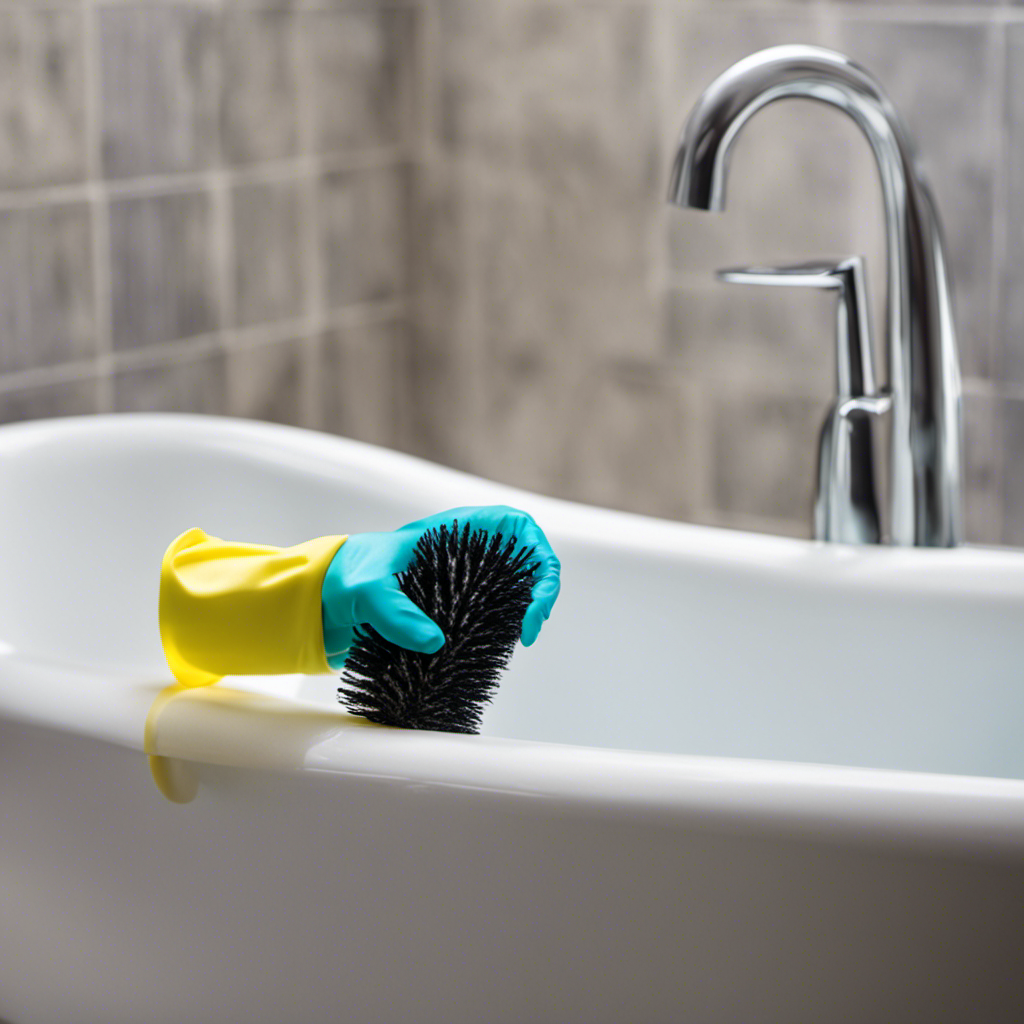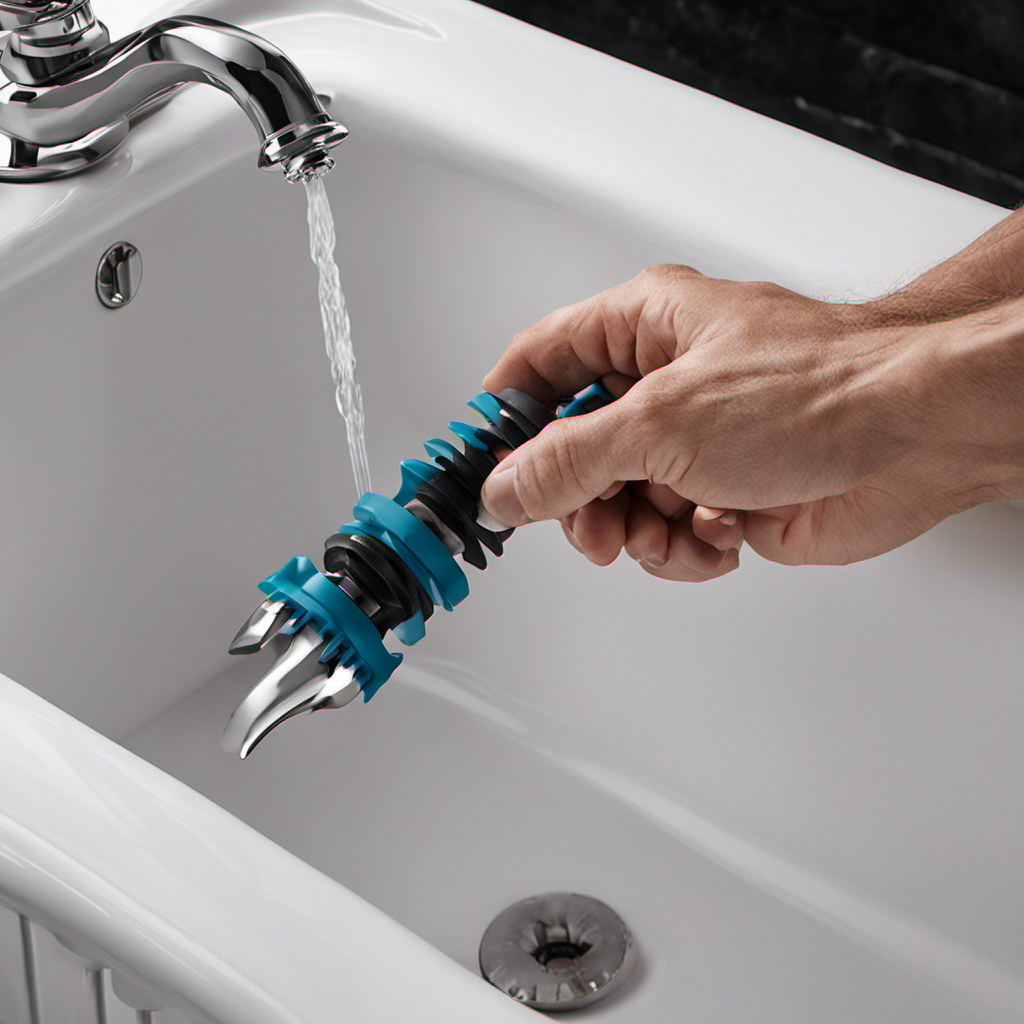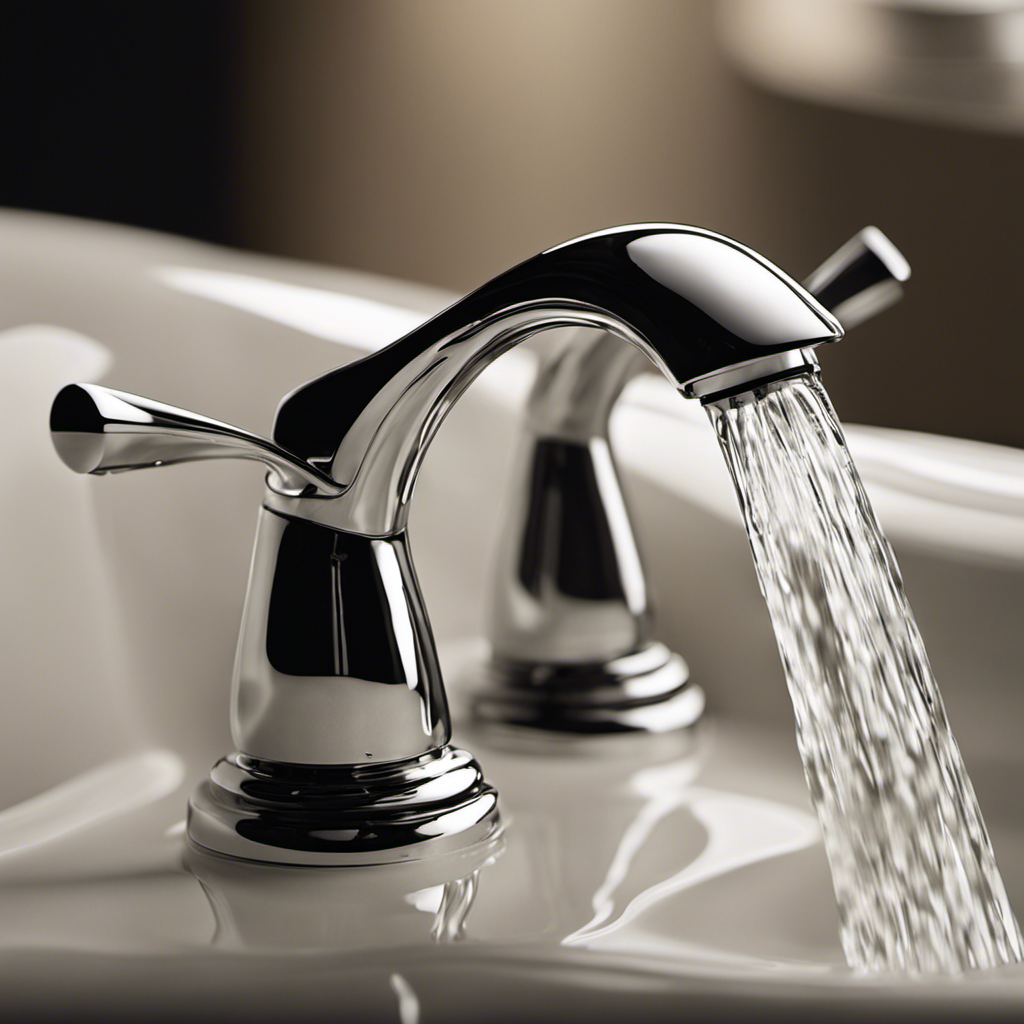I know how frustrating it can be to deal with a clogged bathtub drain. The water slowly pooling at your feet, the unpleasant smell lingering in the air – it’s enough to ruin any relaxing bath.
But fear not, because I’m here to guide you through the process of cleaning your bathtub drain stopper. With just a few simple steps and the right tools, you’ll have your drain flowing smoothly again in no time.
So let’s dive in and get that drain back in tip-top shape!
Key Takeaways
- There are different types of bathtub drain stoppers, including pop-up stoppers and rubber stoppers.
- Metal stoppers are durable and resistant to corrosion, while plastic stoppers are affordable and lightweight.
- Rubber stoppers are flexible and easy to clean, while silicone stoppers are durable and resistant to mold.
- To clean a bathtub drain stopper, remove it, inspect and remove any hair or debris, soak and scrub it in a solution, and then reinstall it into the drain.
Types of Bathtub Drain Stoppers
There are two main types of bathtub drain stoppers that you can choose from.
The first type is the pop-up stopper, which is commonly found in modern bathrooms. This stopper is connected to a lever or knob on the overflow plate, allowing you to easily open and close the drain. The advantage of the pop-up stopper is that it provides a tight seal, preventing water from draining out. However, it can be prone to clogging due to hair and debris getting caught in the mechanism.
The second type is the rubber stopper, also known as a flat or suction stopper. It is a simple and inexpensive option that creates a seal by covering the drain hole. While it may not provide as tight a seal as the pop-up stopper, it is easier to clean and less likely to clog.
When it comes to unclogging techniques, both types of stoppers can be removed and cleaned manually. For the pop-up stopper, you will need to unscrew the overflow plate and lift out the stopper assembly. With the rubber stopper, you simply need to pull it out of the drain.
As for the materials, pop-up stoppers are typically made of metal, brass, or plastic, while rubber stoppers are made of rubber or silicone. The pros of metal stoppers are their durability and resistance to corrosion, but they can be more expensive. Plastic stoppers are affordable and lightweight but may not be as long-lasting. Rubber stoppers are flexible and easy to clean, but they may wear out over time. Silicone stoppers are durable and resistant to mold, but they can be more expensive.
Necessary Tools for Cleaning
To clean the bathtub drain stopper, you’ll need a few necessary tools. Here are three items that will help you effectively clean your drain stopper:
-
Rubber gloves: These will protect your hands from coming into contact with any dirt, grime, or chemicals during the cleaning process.
-
Plunger: A plunger can be used to remove any clogs or debris that may be preventing your drain stopper from working properly.
-
Pipe brush: This long, flexible brush is perfect for reaching deep into the drain pipe and scrubbing away any built-up residue or hair.
Using these tools, you can easily tackle the task of cleaning your bathtub drain stopper. Remember to use effective cleaning solutions and follow proper DIY drain stopper removal techniques to ensure a thorough and successful cleaning process.
Step-by-Step Cleaning Process
Using rubber gloves, a plunger, and a pipe brush, you can easily tackle the task of cleaning your drain stopper.
To begin, make sure you have the necessary cleaning products, such as a mild detergent or vinegar.
Start by removing the drain stopper from the drain, twisting it counterclockwise. Once removed, inspect the stopper for any hair or debris that may be clogging it. You can use a pair of tweezers or a toothbrush to remove any visible hair.
Next, fill a bucket or sink with warm water and add a small amount of detergent or vinegar. Submerge the drain stopper in the solution and use a pipe brush to scrub away any residue.
Rinse the stopper thoroughly and reinstall it into the drain.
Tips for Preventing Clogs
One way to prevent clogs in your bathtub is by regularly removing hair and debris from the drain. This simple task can help maintain the proper flow of water and prevent buildup that can lead to clogs. Here are three effective drain cleaning methods that can help you keep your bathtub drain clear:
- Regularly use a drain snake or auger to remove hair and other debris from the drain.
- Use a mixture of baking soda and vinegar to dissolve any buildup in the drain.
- Install a hair catcher or strainer over the drain to prevent hair from going down the drain in the first place.
Proper drain maintenance is of utmost importance to ensure the longevity of your plumbing system. Regularly cleaning the drain not only prevents clogs but also improves the overall efficiency of your bathtub. By incorporating these effective drain cleaning methods and understanding the importance of proper drain maintenance, you can keep your bathtub drain clear and functional.
Transitioning into the next section, let’s now discuss the importance of maintenance and regular cleaning to further prevent clogs and keep your bathtub drain in optimal condition.
Maintenance and Regular Cleaning
Regularly removing hair and debris from your bathtub drain can help prevent clogs and maintain proper water flow. It is important to regularly clean and maintain your bathtub drain stopper to ensure it functions properly.
Over time, the drain stopper can become clogged with hair, soap scum, and other debris, causing water to drain slowly or not at all. To clean the drain stopper, start by removing it from the drain. Use a pair of pliers to unscrew the stopper and carefully lift it out. Clean any hair or debris from the stopper using a brush or toothbrush.
Additionally, using a drain strainer can further prevent clogs by catching hair and other debris before it enters the drain. By regularly cleaning the drain stopper and using a drain strainer, you can maintain proper water flow and prevent the need for bathtub drain stopper replacement.
Frequently Asked Questions
How Often Should I Clean the Bathtub Drain Stopper?
I clean my bathtub drain stopper about once a month to prevent clogs. It’s important to regularly remove hair and debris from the stopper to maintain proper drainage. Using the best cleaning products can help keep it clean and functioning well.
Can I Use Bleach to Clean the Bathtub Drain Stopper?
I wouldn’t recommend using bleach to clean the bathtub drain stopper. Instead, try using vinegar, which is a natural and effective alternative. There are also other methods available to clean the stopper thoroughly.
What Should I Do if the Bathtub Drain Stopper Is Stuck?
If my bathtub drain stopper is stuck, there are a few things I can do. First, I’ll check for common causes of obstruction, like hair or soap scum. If that doesn’t work, I’ll try using a plunger or a drain snake to clear the blockage. Regular bathtub drain maintenance can help prevent this issue.
How Do I Remove Rust Stains From the Bathtub Drain Stopper?
To remove rust stains from the bathtub drain stopper, I recommend using the best cleaning products specifically designed for rust stain removal. It’s important to follow the instructions carefully and thoroughly clean the affected area.
Is It Necessary to Remove the Bathtub Drain Stopper for Cleaning?
It is necessary to remove the bathtub drain stopper for cleaning. There are various cleaning techniques available, such as using baking soda and vinegar or a drain cleaning solution. Alternative methods include using a pipe snake or a plunger.
Conclusion
In conclusion, taking the time to clean your bathtub drain stopper not only ensures a smoothly functioning drain but also symbolizes a sense of cleanliness and order in your daily life.
By diligently following the step-by-step cleaning process, using the necessary tools, and implementing preventive measures, you can maintain a clog-free bathtub.
Remember, regular maintenance and cleaning are crucial to preventing future issues.
Embrace the symbolism of a clean drain, and enjoy a refreshing and rejuvenating bathing experience every time.










